Update
What Are They Doing?
 A hole drilled for a string of IceCube light detectors. Photo by Casey O'Hara.
A hole drilled for a string of IceCube light detectors. Photo by Casey O'Hara.
How do you find something that isn't directly visible? That's the challenge faced by the team who developed the IceCube neutrino detector under the ice at the South Pole. Just as X-rays allow us to see bone fractures, and MRIs help doctors find damage to soft tissue, neutrinos will reveal new information about the universe that can't be seen directly. The in-ice particle detector at the South Pole records the interactions of neutrinos which are nearly massless sub-atomic messenger particles. Neutrinos are incredibly common (about 100 trillion pass through your body as you read this) subatomic particles that have no electric charge and almost no mass. They are created by radioactive decay and nuclear reactions, such as those in the sun and other stars. Neutrinos rarely react with other particles; in fact, most of them pass through objects (like the earth) without any interaction. This makes them ideal for carrying information from distant parts of the universe, but it also makes them very hard to detect.
All neutrino detectors rely on observing the extremely rare instances when a neutrino does interact with a proton or neutron. This transforms the neutrino into a charged particle of the same type as the neutrino flavor (electron, muon, or tau). Muons are charged particles that can travel for 5-10 miles (8-16 kilometres) through matter depending on their energy, and generate detectable light in translucent media.
IceCube is made up of thousands of sensitive light detectors embedded in a cubic kilometre of ice between 1450 m and 2450 m below surface. The sensors are deployed on strings in the ice holes that were made using a hot water drill. IceCube detects about 100,000 neutrinos a year, and has a projected life time of two decades. The data collected will be used to make a "neutrino map" of the universe and to learn more about astronomical phenomena, like gamma ray bursts, black holes, exploding stars, and other aspects of nuclear and particle physics. However, the true potential of IceCube is discovery; the opening of each new astronomical window leads to unexpected discoveries.
Where Are They?
 The IceCube building. Photo by Katey Shirey.
The IceCube building. Photo by Katey Shirey.
The team works at the Amundsen-Scott South Pole Station in Antarctica—the southernmost continually inhabited place on the planet. The IceCube site is about one kilometer from the South Pole Station, which supplies the necessary logistics of food, power, and shelter. Despite the cold outside, life inside the station is relatively luxurious with comfortable beds, cooked meals, and showers twice a week. The South Pole is reached by plane from McMurdo Station on the coast of Antarctica from the end of October through February, after which time temperatures become too low for planes to operate safely. About 40 people stay there the rest of the year, which is known as wintering over. IceCube has two people dedicated to overseeing the operation of the telescope during this period at the South Pole.
Latest Journals

Dr. Madsen is the chair of the Physics Department at UW-River Falls and Associate Director of the IceCube Neutrino Observatory where he directs the education and outreach program. His research interests include heliophysics and astrophysics, which he has studied at his various projects in Antarctica. In addition to research, Dr. Madsen is committed to reaching a broad audience beyond the research community. He is involved in education and outreach for the IceCube project including professional development courses for teachers and science and math instruction for the UWRF Upward Bound Program. He collaborates with a number of programs and institutions in addition to PolarTREC, including the Knowles Science Teaching Foundation, UW-River Falls Upward Bound and McNair Programs, and service groups (Rotary International, Boy and Girl Scouts, university alumni associations, etc.). You can read more about Dr. Madsen's work here and here.
"Working in Antarctica is a wonderful adventure, and it is great to provide opportunities for others to have this awesome experience."



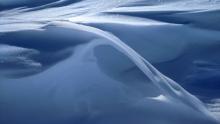

 Katey Shirey and Kate Miller pose next to the poster at the Knowles Teacher Initiative Summer Meeting 2017.
Katey Shirey and Kate Miller pose next to the poster at the Knowles Teacher Initiative Summer Meeting 2017. Kate showing students where the South Pole is on a blow up globe at NSF's Bring-Your-Daughter-or-Son-to-Work Day. Credit: Peter West (NSF)
Kate showing students where the South Pole is on a blow up globe at NSF's Bring-Your-Daughter-or-Son-to-Work Day. Credit: Peter West (NSF)
 Kate shows off the Digital Optical Module (DOM) to students at NSF's Bring-Your-Daughter-or-Son-to-Work Day. Credit: Peter West (NSF)
Kate shows off the Digital Optical Module (DOM) to students at NSF's Bring-Your-Daughter-or-Son-to-Work Day. Credit: Peter West (NSF)
 A young girl looks on as Kate presents at NSF's Bring-Your-Daughter-or-Son-to-Work Day. Credit: Peter West (NSF)
A young girl looks on as Kate presents at NSF's Bring-Your-Daughter-or-Son-to-Work Day. Credit: Peter West (NSF)
 Kate presents to elementary-aged children at NSF's Bring-Your-Daughter-or-Son-to-Work Day. Credit: Peter West (NSF)
Kate presents to elementary-aged children at NSF's Bring-Your-Daughter-or-Son-to-Work Day. Credit: Peter West (NSF)
 Katey presents to elementary-aged children at NSF's Bring-Your-Daughter-or-Son-to-Work Day. Credit: Peter West (NSF)
Katey presents to elementary-aged children at NSF's Bring-Your-Daughter-or-Son-to-Work Day. Credit: Peter West (NSF)
 Katey explains what a neutrino is to elementary-aged children. Credit: Peter West (NSF)
Katey explains what a neutrino is to elementary-aged children. Credit: Peter West (NSF)
 Kate shows students the inner workings of the Digital Optical Module (DOM). Credit: Peter West (NSF)
Kate shows students the inner workings of the Digital Optical Module (DOM). Credit: Peter West (NSF)
 Katey helps kids try on the ECW at NSF's Bring-Your-Daughter-or-Son-to-Work Day. Credit: Peter West (NSF)
Katey helps kids try on the ECW at NSF's Bring-Your-Daughter-or-Son-to-Work Day. Credit: Peter West (NSF) Kate poses with members of Friends of the Planetarium. (Photo Credit: Kathi Overton)
Kate poses with members of Friends of the Planetarium. (Photo Credit: Kathi Overton)
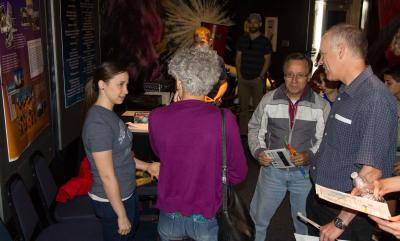 Kate talks with audience members after the planetarium presentation. (Photo Credit: Kathi Overton)
Kate talks with audience members after the planetarium presentation. (Photo Credit: Kathi Overton)
 Kate talks with an interested member of the public after the planetarium presentation. (Photo Credit: Kathi Overton)
Kate talks with an interested member of the public after the planetarium presentation. (Photo Credit: Kathi Overton)
 Kate discusses the ECW and life in Antarctica with interested members of the public. (Photo Credit: Kathi Overton)
Kate discusses the ECW and life in Antarctica with interested members of the public. (Photo Credit: Kathi Overton)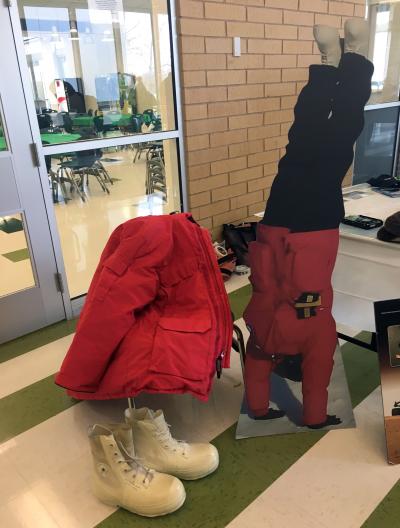 ECW and Kate's handstand cutout displayed at the Dream, Explore, Create Your Own Path event.
ECW and Kate's handstand cutout displayed at the Dream, Explore, Create Your Own Path event.
 Antarctica souvenirs and neutrino stuffed animals on display at the Dream, Explore, Create Your Own Path event.
Antarctica souvenirs and neutrino stuffed animals on display at the Dream, Explore, Create Your Own Path event.
 A young boy at the Dream, Explore, Create Your Own Path event tries on the ECW goggles.
A young boy at the Dream, Explore, Create Your Own Path event tries on the ECW goggles.
 A boy at the Dream, Explore, Create Your Own Path event trying on "Big Red."
A boy at the Dream, Explore, Create Your Own Path event trying on "Big Red."
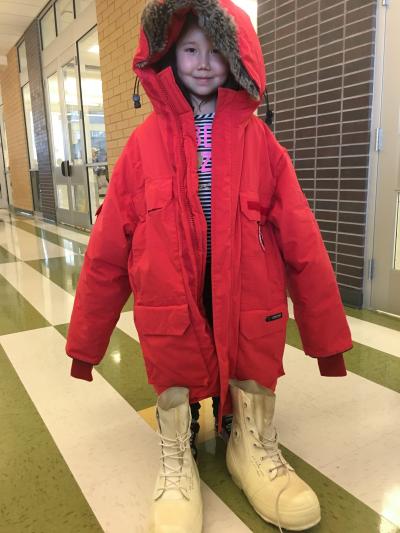 The ECW is a bit big on this girl at the Dream, Explore, Create Your Own Path event.
The ECW is a bit big on this girl at the Dream, Explore, Create Your Own Path event.
 Trying on the bunny boots at the Dream, Explore, Create Your Own Path event.
Trying on the bunny boots at the Dream, Explore, Create Your Own Path event.
 A boy tries to walk in a bunny boot at the Dream, Explore, Create Your Own Path event.
A boy tries to walk in a bunny boot at the Dream, Explore, Create Your Own Path event.
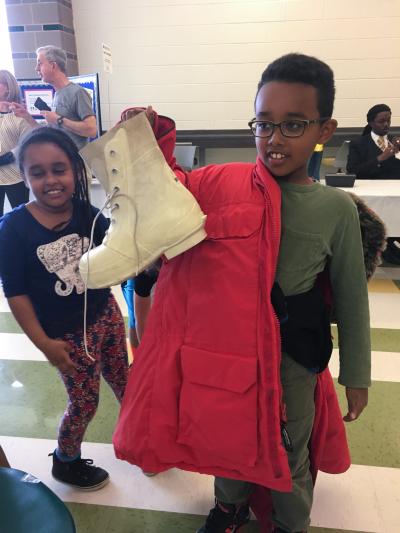 A young boy models some ECW as his sister looks on at the Dream, Explore, Create Your Own Path event.
A young boy models some ECW as his sister looks on at the Dream, Explore, Create Your Own Path event.
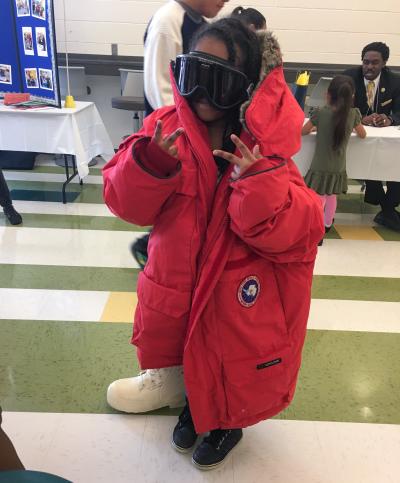 Two peace signs in the ECW at the Dream, Explore, Create Your Own Path event.
Two peace signs in the ECW at the Dream, Explore, Create Your Own Path event.
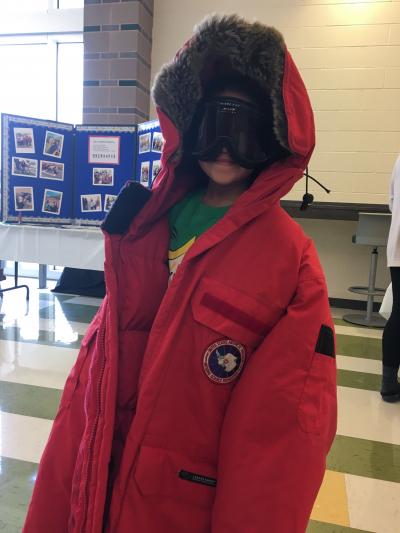 Another young scientist modeling ECW at the Dream, Explore, Create Your Own Path event.
Another young scientist modeling ECW at the Dream, Explore, Create Your Own Path event.
 The ECW is a little big on this tiny scientist at the Dream, Explore, Create Your Own Path event.
The ECW is a little big on this tiny scientist at the Dream, Explore, Create Your Own Path event. Kate Miller at the South Pole (Photo courtesy ARCUS).
Kate Miller at the South Pole (Photo courtesy ARCUS). Kate at The Radio Hotline with Dennis Price
Kate at The Radio Hotline with Dennis Price